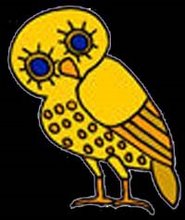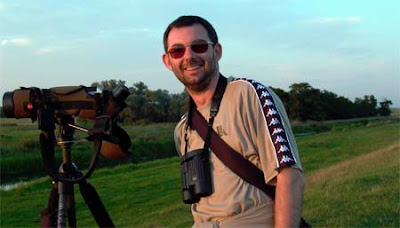






 Corncrakes illegally hunted near Agiasos, Sept 07. Photo E. Kakalis courtesy HOS.
Corncrakes illegally hunted near Agiasos, Sept 07. Photo E. Kakalis courtesy HOS. Sorry, I'm not one of life's naturals in front of the camera. All the ones below are from one of my Gambian trips with Liz - she's usually the only one who can get a shot of me! Here I've been captured on a summer's evening birding the Nene Washes.
Sorry, I'm not one of life's naturals in front of the camera. All the ones below are from one of my Gambian trips with Liz - she's usually the only one who can get a shot of me! Here I've been captured on a summer's evening birding the Nene Washes.
 I was an early digiscoper but since I rarely carry a scope in anger in the UK anymore, the chances are few. Digiscoping is now mainly something I do on trips.
I was an early digiscoper but since I rarely carry a scope in anger in the UK anymore, the chances are few. Digiscoping is now mainly something I do on trips. One of life's great feelings - being utterly, but pleasantly, exhausted from a great days birding in somewhere like The Gambia.
One of life's great feelings - being utterly, but pleasantly, exhausted from a great days birding in somewhere like The Gambia. . . . but some days are simply too much! This was towards the end of a great two-week holiday with Liz in The Gambia. We were on our way back to the coast along the River Gambia and just at this point only a shout for Pel's Fishing Owl would have raised me!
. . . but some days are simply too much! This was towards the end of a great two-week holiday with Liz in The Gambia. We were on our way back to the coast along the River Gambia and just at this point only a shout for Pel's Fishing Owl would have raised me!

 Scops Owl
Scops Owl  Potamia Valley
Potamia Valley  On our travels we will also look out for roof- and chimney- top nesting White Storks
On our travels we will also look out for roof- and chimney- top nesting White Storks Baillon's Crake - the rarest of the crakes is found most springs at sites such as Metochi Lake or the Meladia River Ford
Baillon's Crake - the rarest of the crakes is found most springs at sites such as Metochi Lake or the Meladia River Ford

 Little Bitterns occur at many wetland sites and rivers
Little Bitterns occur at many wetland sites and rivers
 Olive grove - there are an estimated 11 million olive trees on Lesvos. Thats a lot of olives!
Olive grove - there are an estimated 11 million olive trees on Lesvos. Thats a lot of olives!
 Red-footed Falcons can appear anywhere on there way north to eastern European breeding grounds
Red-footed Falcons can appear anywhere on there way north to eastern European breeding grounds View of part of the vast Kalloni Saltpans. The salt mound can be seen in the distance
View of part of the vast Kalloni Saltpans. The salt mound can be seen in the distance The harbour at Agios Fokas
The harbour at Agios Fokas
The Napi Valley runs north from the Kalloni Saltpans. It provides a natural corridor for birds heading straight through or leaving the pans after a pit stop. We’ll search this softly-undulating valley with its tree-peppered slopes, and its surrounds, for resident and migrating raptors, Hoopoe, Middle Spotted Woodpecker, Rock Nuthatch, Sombre Tit, Black-eared Wheatear, Subalpine and Orphean Warblers and much more! Platania lies at the top of the valley and is one of the most beautiful walks on the island, and from late April plays host to Olive Tree Warbler.
 Rock Nuthcatch occurs in rocky areas across the island
Rock Nuthcatch occurs in rocky areas across the island
We will search the nooks and crannies of the north coast for migrants refuelling for the hop over to Turkey which is almost touchable here across the narrow straights. The skies are always worth checking for raptors as the hills provide the perfect thermal updrafts for northerly-heading migrants as well as thermal fun rides for breeding species such as Long-legged Buzzard and Short-toed Eagle (both on the look out Montpellier or Whip Snakes or Balkan Wall and Agama Lizards). Breeding birds include Blue Rock Thrush, Black-eared Wheatear, Masked Shrikes, Sombre Tit, Orphean Warbler and Black-headed and Cretzschmar’s Buntings (see banner at top of page), whilst offshore we’ll look for the two Medierranean shearwater species, Yelkouan (the eastern Med race of Mediterranean Shearwater) and Scolpoli’s (the eastern Med race of Cory’s) and Audouin’s Gull. This coastline is also great for butterflies Scarce Swallowtail and Cleopatra.
 The song of the Cirl Bunting is one of the ever-present sounds of Lesvos
The song of the Cirl Bunting is one of the ever-present sounds of Lesvos
 The amazing and beautiful Thread Lacewing
The amazing and beautiful Thread Lacewing
The villages and towns of this northern area are both picture postcard and varied - the beautiful fishing harbour village of Skala Sikaminias, overlooked by its inland cousin Sikaminia clinging to its hillside perch, whilst the castle-capped town of Molivos can be seen for many miles in most directions boasts a beautiful harbour and steep and narrow streets.
 Sikaminia - one of the many villages clinging to steep hillsides
Sikaminia - one of the many villages clinging to steep hillsides
 Molivos harbour
Molivos harbour
Between Petra and Molivos we will search the headland areas for migrants and the scarce breeding Rüppell’s Warbler. This scarce syvlia warbler is a star attraction with its white moustaches slicing through its black hood.
 Male Rüppell's Warbler
Male Rüppell's Warbler
Travelling west the island becomes more arid and at times utterly barren as volcanic hillsides replace the olive groves and oak-clad hills. The rocky areas are home to the rare lemon-headed Cinereous Bunting and Rock Sparrow whilst Rock Nuthatches bounce around the rocks with beakfuls of insects which they ferry to their young tucked up safely in funnel-shaped nests made of mud clinging to the face of a rock.
 Male Cinereous Bunting
Male Cinereous Bunting
Ipsilou Monastery has perched high on its mountain top and has seen more than its fair share of sackings. From its top you can view the island in all directions whilst searching the skies for raptors and swifts which are just as likely to appear below you as they are above you! Eagles, Honey-buzzard, Lesser Kestrel and Eleanora’s Falcon, Levant Sprrowhawk, Alpine and Pallid Swifts, Crag Martins and other hirundiens should all be hoped for. The tree-clad slopes may look quiet, but during a good fall the trees and bushes can be dripping with migrant warblers, flycatchers, chats, shrikes and Golden Oriole. The rocky parts of the mountain slopes should be checked for Rock Sparrow, Blue Rock Thrush, Cinereous and Cretzschmar's Buntings, Isabelline and Black-eared Wheatears and Little Owl. The meadow areas are packed with flowers and if you see a moving boulder it will be either a Chukar or Spur-thighed Tortoise! The monastery itself should be visited. Its chapel is simply stunning and Persian Squirrels scurry around the monastery walls.
 Spur-thighed Tortoise
Spur-thighed Tortoise
At the far western end of the island lies Sigri. Here the coastal fields provide a lush green oasis to tempt down hungry migrants. These fields lead to the sheltered Faneromeni River, flanked on either side by tall stands of bamboo which can provide refuge for tired migrants. If the river holds water Little Bittern and Great Snipe might be found out in the open. Lesser Kestrels and migrant harriers hunt over the surrounding hills, meadows and beaches where we also stand a change of finding such scarcities such as Roller and Collared Flycatcher.
Time permitting, in Sigri we might visit the newly opened Petrified Forest Museum (entry €5). Outside the museum lie huge stumps of a petrified trees, redwoods and pines that were covered in volcanic ash and turned to stone millions of years ago. The museum itself explains the process brilliantly and contains numerous other petrified items and geological finds from both Lesvos and further a field.
Along the 13km rough track which serves as a road connecting the towns of Sigri and Eresos, lies the Meladia River Valley. This forms a wide, flat plain at its mouth, narrowing quickly to the north pointing directly up to the mount of Ipsilou. This flat plain is one of the magnets for newly arriving migrants. The small ford pools offer shelter, food and water for Great Reed Warbler, crakes and herons. The open scrubby plain itself can swarm with ‘yellow’ wagtails, pipits and buntings, whilst the nearby fig grove can be dripping with warblers, flycatchers, Bee-eaters and Golden Orioles. Rufous Bush Robins should be on territory from early May. It’s a rare day you don’t get something here.
 The Meladia River plain
The Meladia River plain
 Rufous Bush Robin breeds near the Meladia River Mouth and many other scrubby areas across the island
Rufous Bush Robin breeds near the Meladia River Mouth and many other scrubby areas across the island
Whilst travelling around this incredibly beautiful and varied island, wherever we are we will have magnificent scenery forming stunning backdrop to our days birding.
 One of my many happy groups (and friends!) I've led around Lesvos
One of my many happy groups (and friends!) I've led around Lesvos
I encourage everyone to submit their bird records. You can do this as follows:
For the Lesvos annual bird report - you can send your records direct to me by email. I prefer records to be sent as Excel files and should preferably include columns as follows - species name, number of birds, date, location, your name and other observers. I will let you know if the Lesvos Bird Records Committee (of which I am a member) require any further details of any particular record.
You can also submit your records via OrnithoTopos which is an Internet-based spatial database about birds, their science and their distribution, that allows users from anywhere in the world to input and query Greek bird data.
 For nationally rare species, these should be submitted to the Hellenic Rarities Committee (Greek equivelant of BBRC). Check the HRC website for species it covers.
For nationally rare species, these should be submitted to the Hellenic Rarities Committee (Greek equivelant of BBRC). Check the HRC website for species it covers.
The Hellenic (Greek) Rarities Committee (HRC) was founded in 2004 and publishes its annual reports online -
From Nikos Probonas (HRC secretary) -
HRC are in the process of re-organizing our archives, especially the photo material, and we would like to ask for assistance regarding photos of rare species in Greece. If you are aware of such photos, not appearing on the HRC website gallery, we would appreciate if you informed us of their existence and the way to obtain them (URL of website or email of phorographer). We are interested even in the oldest photos.
The full list of the rare species for Greece can be seen here.
HRC would like to thank all those who have already submitted their records of rare birds seen in Greece.
Please do not hesitate to ask for any clarification on birds@ornithologiki.gr or hellenicbirds@yahoo.gr
Good birding.
Nikos Probonas
HRC Secretary
Go to the HRC website
